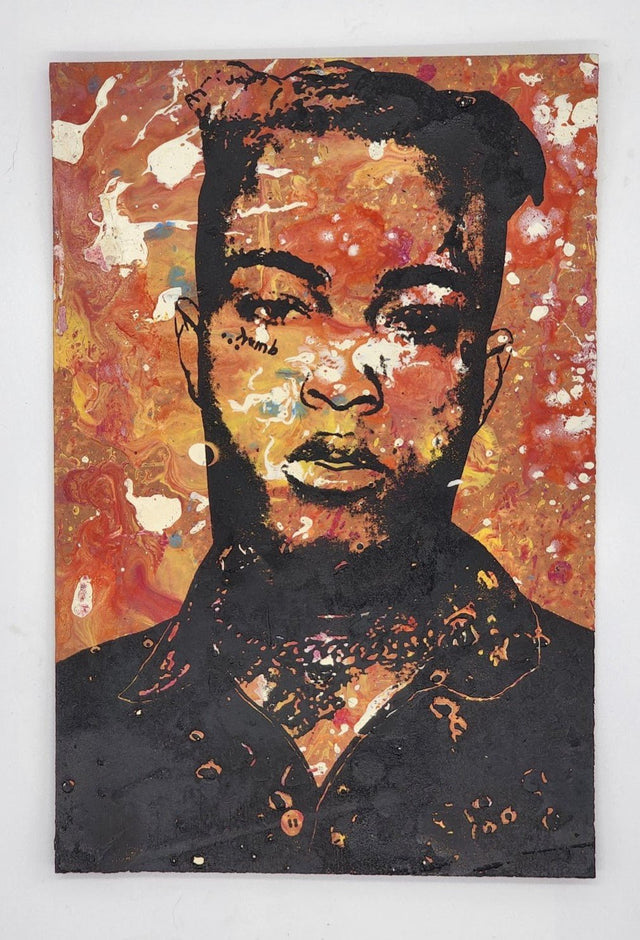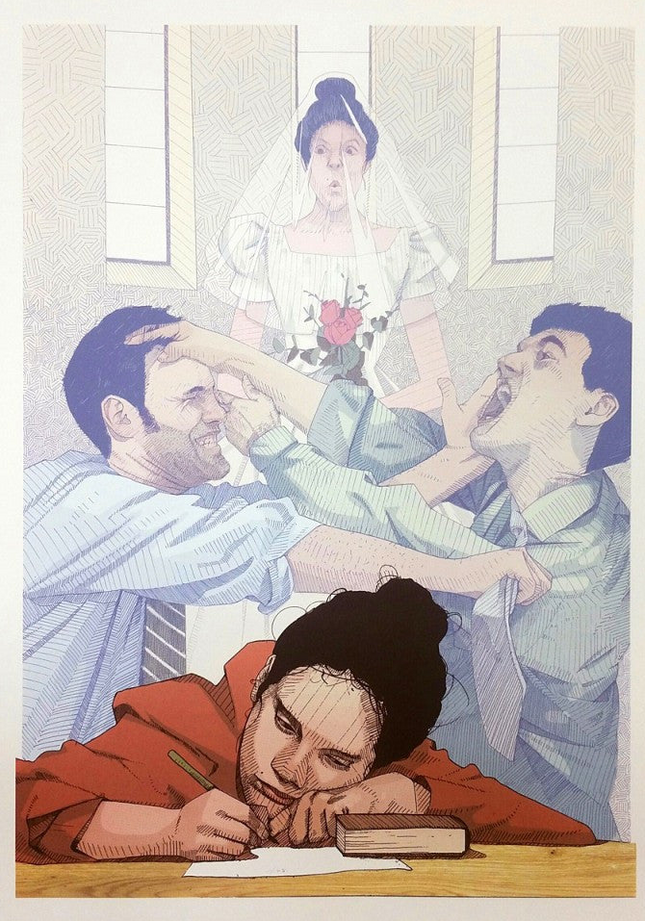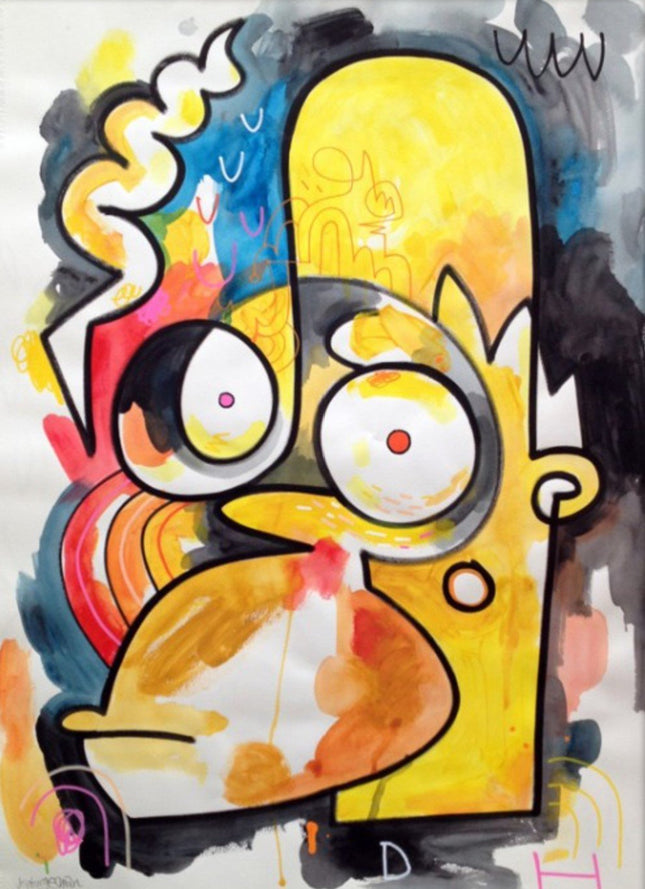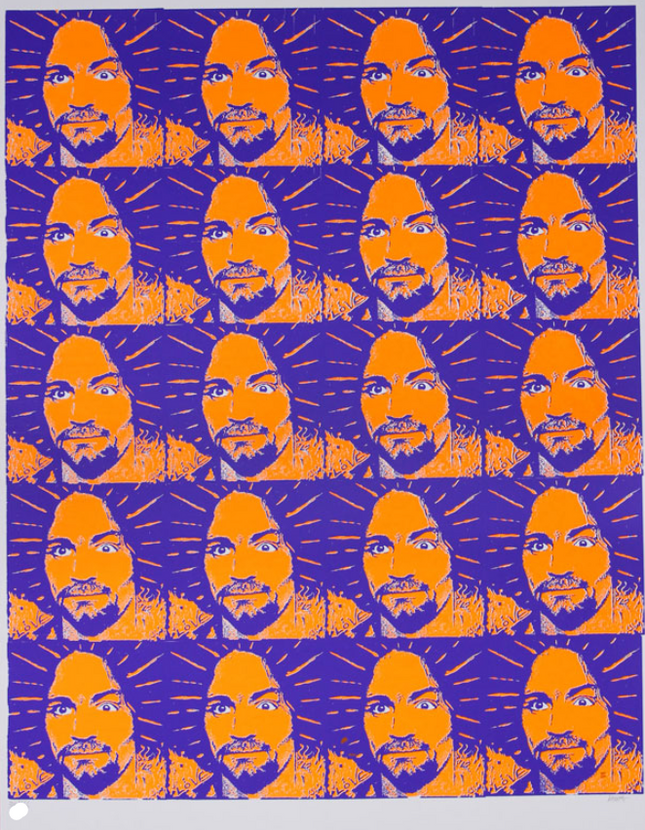
Man Male
-

Bezt- Etam Cru Girl's Dream PP Silkscreen Print by Bezt- Etam Cru
Girl's Dream PP Printers Proof Silkscreen Print by Bezt- Etam Cru Artist Proof Hand-Pulled 7-Color Screen Print on Deckled Coventry Rag Fine Art Paper Limited Edition Pop Street Artwork & Graffiti. PP Printers Proof 2015 Signed & Marked PP Limited Edition Run Hand Deckled Artwork Size 21.25x29.5- Creasing Along Top, Left & Right Margin, Image Only Affected Across Top Extreme. As Received From Artist/Printer. Damage Photos Taken in Protective Covering. Girl's Dream PP: A Visionary Silkscreen by Bezt of Etam Cru Girl's Dream PP, a Printer's Proof silkscreen print by Bezt of Etam Cru, emerges as a striking illustration of the intersection between Street Pop Art and graffiti Artwork and the meticulous craft of screen printing. Released in 2015, this limited edition artwork is noted for its hand-pulled, 7-color process on deckled Coventry Rag fine art paper, offering a tangible texture that is both visually and tactilely engaging. The artwork, sized 21.25x29.5 inches, features a hauntingly dreamlike vista emblematic of Bezt's narrative-driven approach to art. Signature and Symbolism in Best's Work Signing and marking a Printer's Proof, as seen in Girl's Dream PP, signifies a high level of craftsmanship and the artist's direct involvement in the printmaking process. Being a PP, this print represents one of the rarest forms of a silkscreen, typically reserved for the printer's archive. Bezt's signature authenticates the piece and personally connects the artist to the collector, elevating the print's value within the Street Pop Art and graffiti Artwork community. Craftsmanship in Silkscreen Printing The silkscreen technique employed in Girl's Dream PP is a testament to Bezt's dedication to craftsmanship. The seven-color process requires precise layering and a deep understanding of color interaction to achieve the final image's depth and luminosity. The choice of Coventry Rag paper, known for its durability and rich texture, further underscores the artwork's quality and the artist's commitment to preserving the integrity of the visual narrative through superior materials. Imagery and Interpretation in Girl's Dream Bezt's Girl's Dream PP is replete with symbolism, featuring a central figure enveloped by scenes that evoke a sense of layered storytelling. The ethereal quality of the image invites interpretation, allowing viewers to delve into a narrative that straddles the line between the conscious and the subconscious. This piece illustrates Bezt's ability to capture complex emotional states and translate them into a visual language that resonates within the Street Pop Art and graffiti Artwork genres. Limited Edition and Collectibility The limited edition nature of Girl's Dream PP makes it a sought-after piece for collectors, Street Pop Art, and graffiti Artwork enthusiasts. The hand-deckled edges of the print add an element of bespoke uniqueness, ensuring that no two prints are exactly alike. As street art continues to flourish in the art market, limited editions such as this one gain significance, both as works of art and as investment pieces with the potential to appreciate over time. bezt's Influence on Contemporary Art Bezt's influence on contemporary art is amplified through works like Girl's Dream PP, which blur the boundaries between traditional printmaking and modern street art aesthetics. His contributions to the genre have helped redefine public perceptions of Street Pop Art and graffiti Artwork, positioning it as a vital and sophisticated art form. The continued interest in Bezt's prints, minimal editions such as this Printer's Proof, underscores his artistic vision's enduring appeal and relevance.
$500.00
-

Jon Burgerman Homer Original Pasca Ink Watercolor Painting by Jon Burgerman
Homer Original Painting Pasca and Ink on Watercolor Paper by Artist Jon Burgerman Modern Pop Art. 2014 Signed Original One of a Kind Watercolor Painting Size 22.5x29.5 "Jon Burgerman makes vibrant, neo-primitive scrawls of shapes and color. He's pushed his monster-like characters into compositions where cartoon-like forms are crammed on top of each until they create a screaming mass of energy. Intensely prolific, he has pushed the character obsession of the late 90s into a far more interesting and strong direction. Think Walt Disney at an Incan monument on mescaline." - Francesca Gavin, Visual Arts Editor Dazed & Confused and author of Street Renegades and 100 New Artists published by Laurence King.
$1,917.00 $1,629.00
-

Frank Kozik Charles Manson Everythings Charlie Silkscreen Print by Frank Kozik
Charles Manson Everything Charlie Silkscreen Print by Frank Kozik Hand-Pulled 2-Color on Fine Art Paper Limited Edition Pop Street Art Artwork. 1992 Signed & Numbered Limited Edition of 666 Artwork Size 22.5x29.5 Silkscreen Print Frank Kozik's "Charles Manson Everything Charlie" is a provocative silkscreen print that embodies the raw and often controversial energy of pop and street art. Released in 1992, this artwork reflects Kozik's edgy aesthetic, a bold confrontation of cultural icons and societal motifs that challenge the viewer. The print features a repeated portrait of Charles Manson, infamously known for leading the Manson Family and orchestrating a series of gruesome murders in the late 1960s. With a limited run of 666 pieces, a number playfully nodding to the subject's notoriety, each 22.5x29.5 inch print is signed and numbered by Kozik, asserting its authenticity and rarity. Crafted through a hand-pulled process, the 2-color print starkly contrasts the vibrant orange of Manson's face against a deep blue background, surrounded by what appears to be radiating lines or aura. This choice of color and repetition creates a visual echo chamber, amplifying the unsettling impact of Manson's gaze multiplied across the paper. The artwork encapsulates the spirit of the early '90s alternative scene and the burgeoning interest in street art as social commentary. Kozik's decision to immortalize Manson in this way taps into the vein of pop art tradition, reminiscent of Warhol's depictions of Marilyn Monroe. Yet, it subverts the norm by focusing on a figure associated with darkness and infamy rather than glamour or pop culture innocence. "Everything Charlie" is a stark example of how street art and pop art can converge in a single piece, bringing the outsider ethos and inflammatory messages to the fore. This is street art not confined to the alleys or hidden corners of the city but elevated to fine art, meant to hang on a wall, confront, and provoke. As with much of Kozik's work, the piece is not just a visual stimulus but a conversation starter, a powerful reminder of art's ability to encapsulate complex narratives within simple imagery. It's a window into the era it was produced, a snapshot of the zeitgeist, and a reflection on the culture's fascination with figures like Manson.
$305.00




